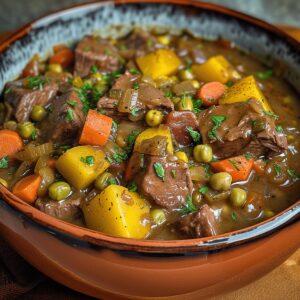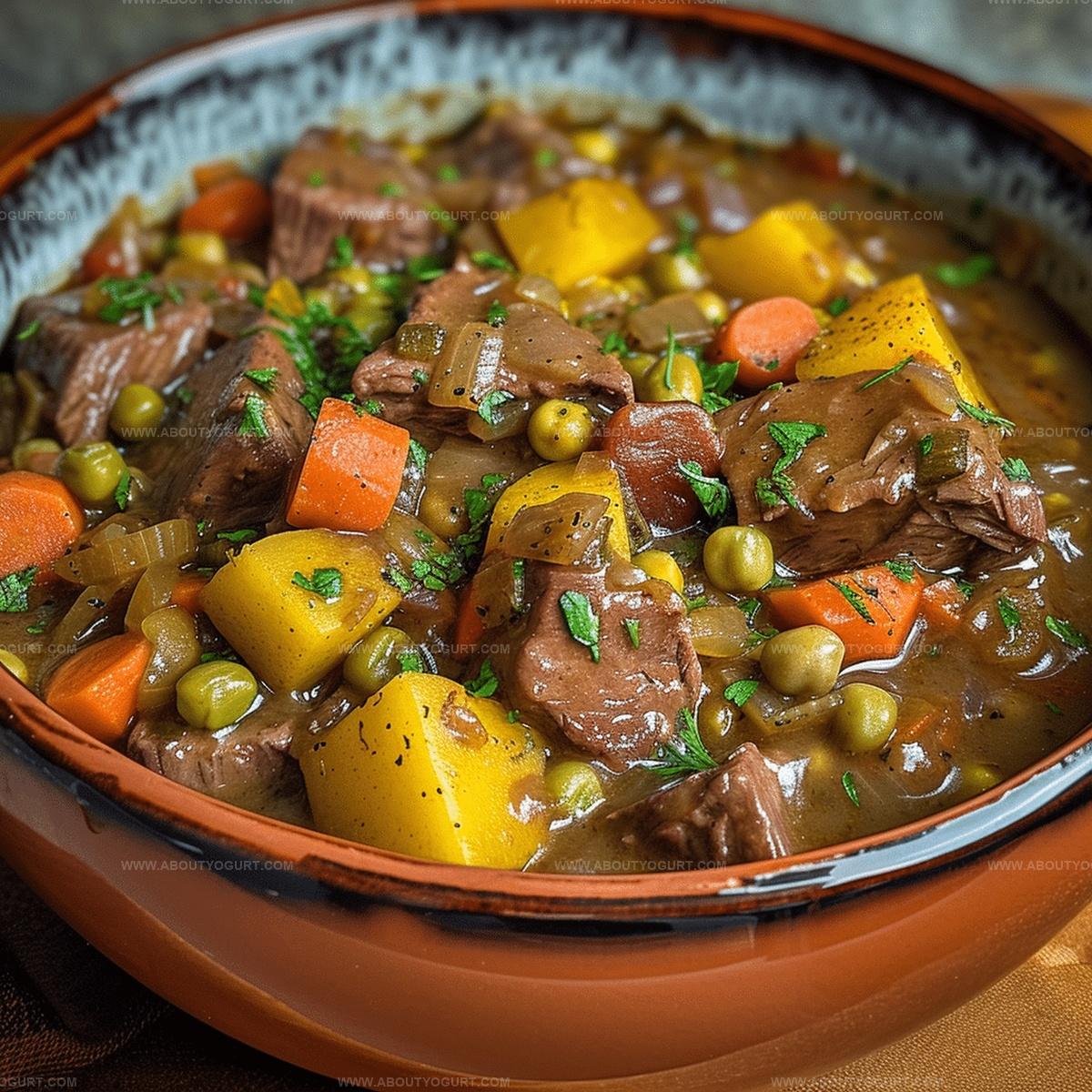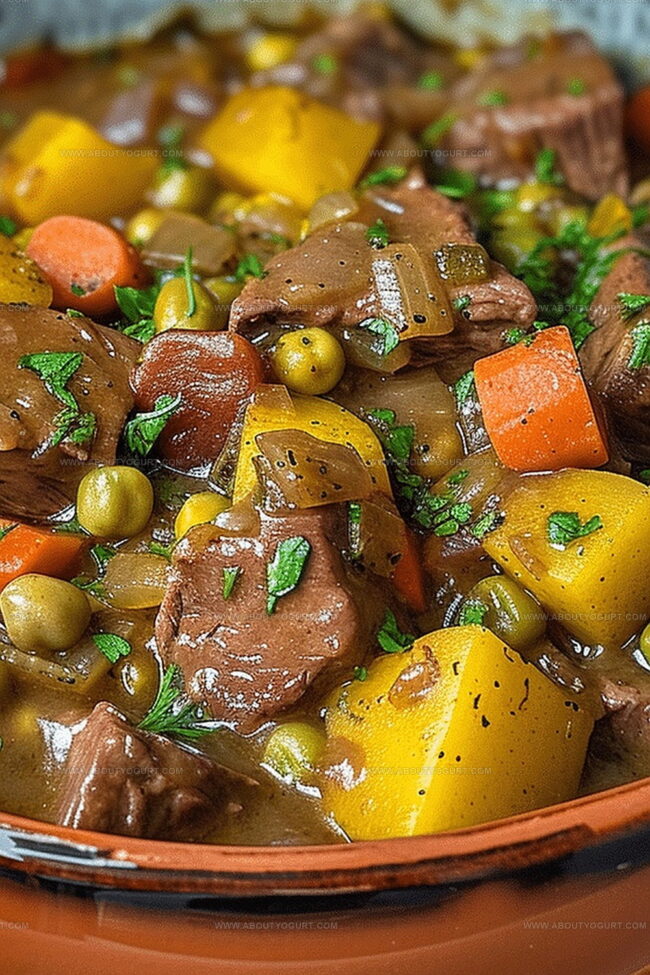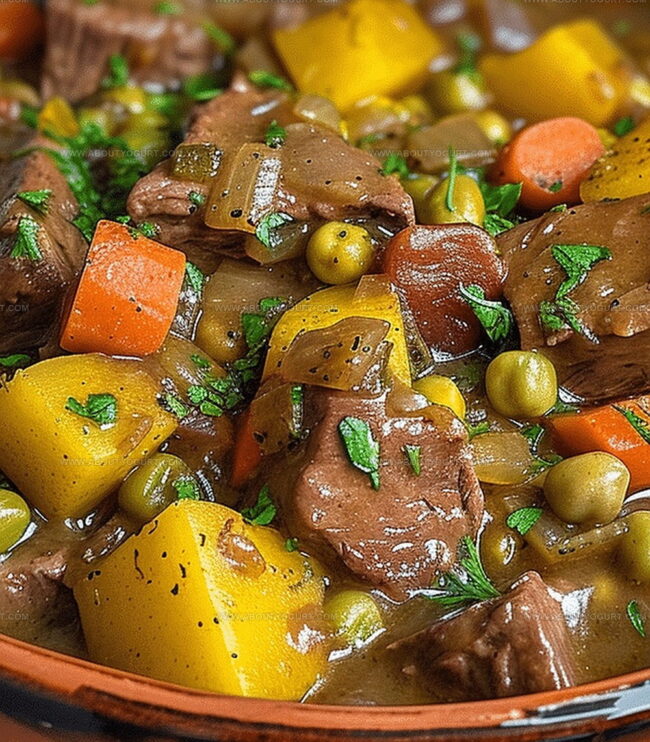Hearty Mulligan Stew Recipe: A Rustic, Soul-Warming Classic
Crafting a hearty mulligan stew brings comfort and nostalgia to your kitchen table.
Hungry travelers and resourceful cooks historically created this dish from whatever ingredients they could scavenge.
Miners, railroad workers, and wandering laborers perfected the art of transforming random pantry items into a nourishing meal.
Potatoes, vegetables, and affordable meat chunks simmer together in a rich, aromatic broth that warms both body and soul.
Seasonal ingredients make each mulligan stew unique, reflecting personal creativity and local availability.
Every spoonful tells a story of resilience and improvisation from America’s culinary past.
Why Mulligan Stew Is a Hearty Comfort Food
Ingredients in Mulligan Stew
Main Protein:Seasoning Blend:Vegetables and Liquid:Cooking Oils:Step-By-Step Instructions for Mulligan Stew
Step 1: Prepare Seasoned Flour Coating
Mix flour, onion powder, garlic powder, and black pepper in a large zipper seal bag. Add beef stew meat and shake thoroughly to coat every piece of meat completely. The coating will help create a delicious crispy exterior and thicken the stew.
Step 2: Brown the Beef
Heat vegetable oil in a Dutch oven over medium heat. Using tongs, transfer the flour-coated beef into the hot pan. Carefully brown the meat on all sides until a golden crust forms, which adds rich flavor to the stew. Once browned, remove beef and set aside on a plate.
Step 3: Create Flavorful Base
Add another splash of vegetable oil to the Dutch oven. Sauté chopped onions until they become soft and translucent. Sprinkle remaining flour into the pan and stir continuously for two minutes. Add oregano, basil, and marjoram to build layers of herbal complexity. Pour in beef broth and stir, creating a smooth, aromatic sauce.
Step 4: Slow Cook the Stew
Return browned beef to the Dutch oven. Cover and transfer to a preheated oven at 350 degrees Fahrenheit. Let the stew simmer for one hour, allowing meat to become tender and flavors to meld together.
Step 5: Add Vegetables
Incorporate a colorful mix of vegetables:Return the pot to the oven and cook for an additional 30 minutes until vegetables are soft and stew reaches perfect consistency.
Pro Tips for a Flavorful Mulligan Stew
Variations to Personalize Mulligan Stew
Ideal Sides and Pairings for Mulligan Stew
Proper Storage of Mulligan Stew
FAQs Regarding Mulligan Stew
A hearty one-pot American dish traditionally made by hobos and travelers using whatever ingredients were available, now evolved into a delicious beef and vegetable stew with rich, comforting flavors.
Browning creates a delicious caramelized exterior that adds deep, complex flavor to the meat and helps seal in the juices, making the beef more tender and flavorful in the final stew.
Absolutely! While oregano, basil, and marjoram create a classic flavor profile, you can substitute with herbs like thyme, rosemary, or Italian seasoning blend to match your taste preferences.
Print
Mulligan Stew Recipe
- Total Time: 1 hour 45 minutes
- Yield: 4 1x
Description
Hearty mulligan stew delivers comfort and nostalgia in one delicious pot, blending classic ingredients with rustic charm. Savory meat, vegetables, and rich broth promise a satisfying meal that warms both body and soul.
Ingredients
Proteins:
- 1 pound (1 lb) beef stew meat
Spices and Seasonings:
- 1/3 cup all-purpose flour
- 1/2 teaspoon onion powder
- 1/2 teaspoon garlic powder
- 1/4 teaspoon fresh ground pepper
- 1/2 teaspoon dried oregano
- 1/4 teaspoon dried basil
- 1/4 teaspoon dried marjoram
Vegetables and Liquids:
- 1 medium onion, chopped
- 2 medium gold potatoes, cubed
- 1 bag (19 ounces / 540 grams) frozen mixed vegetables (corn, carrots, peas and green beans)
- 2 cups low sodium beef broth
- 2 tablespoons vegetable oil
Instructions
- Prepare a seasoning blend by mixing flour, onion powder, garlic powder, and black pepper in a large sealed bag.
- Coat beef stew meat thoroughly in the seasoning mixture, shaking the bag to ensure even coverage.
- Heat vegetable oil in a Dutch oven over medium heat and carefully transfer the seasoned beef using tongs, browning meat on all sides until a rich golden color develops.
- Remove browned beef to a separate plate, reserving any remaining flour mixture.
- In the same Dutch oven, add another tablespoon of vegetable oil and sauté chopped onions for 3-4 minutes until translucent.
- Sprinkle remaining flour into the onions, stirring constantly and cooking for 2 minutes to create a roux.
- Add oregano, basil, and marjoram, stirring continuously for 30 seconds to release their aromatic oils.
- Pour beef broth into the mixture, stirring and allowing the sauce to thicken for 2 minutes.
- Return browned beef to the Dutch oven, cover, and transfer to a preheated 350°F oven for 1 hour.
- After an hour, add potatoes, corn, carrots, peas, and green beans to the stew.
- Return to the oven and continue cooking for an additional 30 minutes or until vegetables are tender and beef is completely soft.
Notes
- Customize the seasoning by adjusting herbs and spices to match your taste preferences, creating a personalized flavor profile.
- Use a cast-iron Dutch oven for even heat distribution and deeper flavor development during slow cooking.
- Swap beef with chicken or plant-based protein for alternative dietary needs, maintaining the stew’s hearty texture and comforting essence.
- Cut vegetables into uniform sizes to ensure consistent cooking and prevent some pieces from becoming mushy while others remain undercooked.
- Prep Time: 10 minutes
- Cook Time: 1 hour 35 minutes
- Category: Lunch, Dinner
- Method: Baking
- Cuisine: American
Nutrition
- Serving Size: 4
- Calories: 317 kcal
- Sugar: 3 g
- Sodium: 230 mg
- Fat: 13 g
- Saturated Fat: 4 g
- Unsaturated Fat: 8 g
- Trans Fat: 0.1 g
- Carbohydrates: 26 g
- Fiber: 5 g
- Protein: 23 g
- Cholesterol: 65 mg




Michael Thompson
Founder & Recipe Developer
Expertise
Education
Cascade Culinary Institute – Bend, OR
ServSafe Food Handler Certification – Portland, OR
Focus: Certified in core food safety and hygiene principles for both home and professional kitchens, with emphasis on ingredient handling, kitchen cleanliness, and safe preparation methods.
Mike’s kitchen journey began with a single goal: to make everyday meals feel like something worth celebrating.
After earning his Certificate in Culinary Arts from Cascade Culinary Institute, he spent years working with local farmers and small kitchens across Oregon, learning the beauty of seasonal, small-batch cooking.
Mike’s approach is simple, cook with what’s fresh, keep it approachable, and always leave room for a little creativity. When he’s not testing yogurt marinades or designing single-serving meals, you’ll find him hiking trails or hunting down the best berries at local markets.